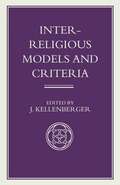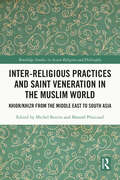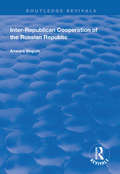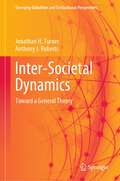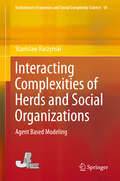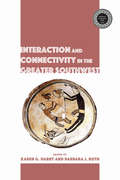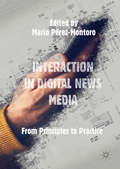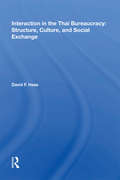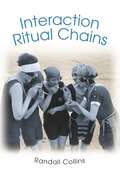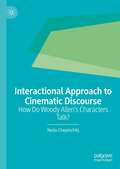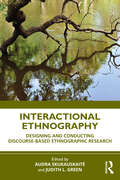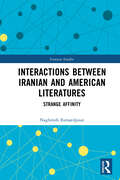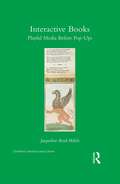- Table View
- List View
Inter-Religious Models and Criteria
by J. KellenbergerThis book is a collection of papers presented and discussed at the 1992 Claremont Conference. Its contributing authors come from various disciplines that share a concern with models and criteria for inter-religious understanding, including religious studies, philosophy of religion, theology, comparative studies, and feminist philosophy.
Inter-religious Practices and Saint Veneration in the Muslim World: Khidr/Khizr from the Middle East to South Asia
by Michel Boivin Manoël PénicaudInter-religious Practices and Saint Veneration in the Muslim World studies the immortal saint Khidr/Khizr, a mysterious prophet and popular multi-religious figure and Sufi master venerated across the Muslim world. Focusing on the religious figure of Khidr/Khizr and the practice of religion from Middle East to South Asia, the chapters offer a multi-disciplinary analysis. The book addresses the plurality in the interpretation of Khizr and underlines the unique character of the figure, whose main characteristics are kept by Muslims, Christians, Hindus and Sikhs. Chapters examine vernacular Islamic piety and intercommunal religious practices and highlight the multiples ways through which Khidr/Khizr allows a conversation between different religious cultures. Furthermore, Khidr/Khizr is a most significant case study for deciphering the complex dialectic between the universal and the local. The contributors also argue that Khidr/Khizr played a leading role in the process of translating a religious tradition into the other, in incorporating him through an association with other sacred characters. Bringing together the different worship practices in countries with a very different cultural and religious background, the study includes research from the Balkans to the Punjabs in Pakistan and in India. It will be of interest to researchers in History, Anthropology, Sociology, Comparative Religious Studies, History of Religion, Islamic Studies, Middle Eastern Studies, South Asian Studies and Southeast European Studies.
Inter-religious Practices and Saint Veneration in the Muslim World: Khidr/Khizr from the Middle East to South Asia
Inter-religious Practices and Saint Veneration in the Muslim World studies the immortal saint Khidr/Khizr, a mysterious prophet and popular multi-religious figure and Sufi master venerated across the Muslim world. Focusing on the religious figure of Khidr/Khizr and the practice of religion from Middle East to South Asia, the chapters offer a multi-disciplinary analysis. The book addresses the plurality in the interpretation of Khizr and underlines the unique character of the figure, whose main characteristics are kept by Muslims, Christians, Hindus and Sikhs. Chapters examine vernacular Islamic piety and intercommunal religious practices and highlight the multiples ways through which Khidr/Khizr allows a conversation between different religious cultures. Furthermore, Khidr/Khizr is a most significant case study for deciphering the complex dialectic between the universal and the local. The contributors also argue that Khidr/Khizr played a leading role in the process of translating a religious tradition into the other, in incorporating him through an association with other sacred characters. Bringing together the different worship practices in countries with a very different cultural and religious background, the study includes research from the Balkans to the Punjabs in Pakistan and in India. It will be of interest to researchers in History, Anthropology, Sociology, Comparative Religious Studies, History of Religion, Islamic Studies, Middle Eastern Studies, South Asian Studies and Southeast European Studies.
Inter-Republican Co-operation of the Russian Republic (Routledge Revivals)
by Anwara BegumFirst published in 1997, this book explored Russia’s politics at an important phase in the life of the Russian state. Focusing on the different types of cooperative interactings between Russia and the fourteen other republics of the former Doviet Union from mid 1990-late 91. The book brings out the nature of the Russians effort to reconfigure its ties with these republics. At a time when the Soviet empire with an aim to limit the damage to the interests of the Russians. As the author concludes, Russia’s inter-republican cooperation was a carefully thought-out policy to undermine the Gorbachev government’s effort to control centre-periphery relations and manage the uncontrolled break-up of the Soviet Union. Russia signalled, through its cooperative relations with the republics, that it was willing to accept the republics as sovereign and view its own interaction with them as inter-state relations.
Inter-Republican Co-operation of the Russian Republic (Routledge Revivals)
by Anwara BegumFirst published in 1997, this book explored Russia’s politics at an important phase in the life of the Russian state. Focusing on the different types of cooperative interactings between Russia and the fourteen other republics of the former Doviet Union from mid 1990-late 91. The book brings out the nature of the Russians effort to reconfigure its ties with these republics. At a time when the Soviet empire with an aim to limit the damage to the interests of the Russians. As the author concludes, Russia’s inter-republican cooperation was a carefully thought-out policy to undermine the Gorbachev government’s effort to control centre-periphery relations and manage the uncontrolled break-up of the Soviet Union. Russia signalled, through its cooperative relations with the republics, that it was willing to accept the republics as sovereign and view its own interaction with them as inter-state relations.
Inter-Societal Dynamics: Toward a General Theory (Emerging Globalities and Civilizational Perspectives)
by Jonathan H. Turner Anthony J. RobertsThis book by Jonathan Turner and Anthony Roberts proposes a new theoretical approach for explaining the dynamics of inter-societal systems. The authors argue that inter-societal systems have existed since the beginning of human societies and the dynamics of these systems are a fundamental property of the social universe. However, while world-systems analysis has emphasized this latter point, the authors argue the reluctance to theorize complex abstract models and systems of explanatory propositions on the dynamics driving inter-societal systems hinders scientific explanation of inter-societal dynamics. In this context, the authors critically look at contemporary theorizing and review key theories that have been developed to explain geo-economic, geo-political, and geo-cultural dynamics, from the classic period through present-day world-systems analysis and cliometrics. The book summarizes these theories clearly, emphasizing their strengths and weakness, finally developing a theoretical synthesis through new models and propositions on the dynamics of premodern and modern inter-societal systems. Professor Turner’s decades of experience writing theory books for undergraduates have ensured that this book presents abstract ideas clearly and with examples so that students can understand the arguments. This book is a must-read for all social theory researchers, academics, serious undergraduate students, graduate students, and interested laypersons.
Inter-war Penal Policy and Crime in England: The Dartmoor Convict Prison Riot, 1932
by A. BrownAn exploration of the 1932 prison riot in Dartmoor Convict Prison. One of the most notorious and destructive in English prison history, it received unprecedented public and media attention. This book examines the causes, events and consequences to shed new light on prison cultures and violence as well as penal policy and public attitudes.
Interacting Complexities of Herds and Social Organizations: Agent Based Modeling (Evolutionary Economics and Social Complexity Science #19)
by Stanislaw RaczynskiThis book presents examples of and the latest simulation studies on artificial societies and populations, highlighting innovative implementations of various models of artificial societies and populations using a new, C++-related simulation tool. It demonstrates that the prey-predator models—including spatial distribution, moving patterns, limited renewable food, fear, gregarious (herd) instinct, clustering, epidemics, and competition—are more complex than other publications have suggested, and highlights the great discrepancy between agent-based and conventional continuous models. The book also discusses the modeling and simulation of self-organization and interactions between organizations, including terror organizations, offering fascinating insights into organizational dynamics. The book provides a broad range of examples and comparisons with the classical dynamics approach, showing readers how to construct models of complex systems. It starts with descriptions of the behavior of interacting individuals and also includes important information on the macro-behavior of the whole system.
Interaction and Connectivity in the Greater Southwest (Proceedings of SW Symposium)
by Karen Harry Barbara J. RothThis volume of proceedings from the fourteenth biennial Southwest Symposium explores different kinds of social interaction that occurred prehistorically across the Southwest. The authors use diverse and innovative approaches and a variety of different data sets to examine the economic, social, and ideological implications of the different forms of interaction, presenting new ways to examine how social interaction and connectivity influenced cultural developments in the Southwest. The book observes social interactions’ role in the diffusion of ideas and material culture; the way different social units, especially households, interacted within and between communities; and the importance of interaction and interconnectivity in understanding the archaeology of the Southwest’s northern periphery. Chapters demonstrate a movement away from strictly economic-driven models of social connectivity and interaction and illustrate that members of social groups lived in dynamic situations that did not always have clear-cut and unwavering boundaries. Social connectivity and interaction were often fluid, changing over time. Interaction and Connectivity in the Greater Southwest is an impressive collection of established and up-and-coming Southwestern archaeologists collaborating to strengthen the theoretical underpinnings of the discipline. It will be of interest to professional and academic archaeologists, as well as researchers with interests in diffusion, identity, cultural transmission, borders, large-scale interaction, or social organization. Contributors: Richard V. N. Ahlstrom, James R. Allison, Jean H. Ballagh, Catherine M. Cameron, Richard Ciolek-Torello, John G. Douglass, Suzanne L. Eckert, Hayward H. Franklin, Patricia A. Gilman, Dennis A. Gilpin, William M. Graves, Kelley A. Hays-Gilpin, Lindsay D. Johansson, Eric Eugene Klucas, Phillip O. Leckman, Myles R. Miller, Barbara J. Mills, Matthew A. Peeples, David A. Phillips Jr., Katie Richards, Heidi Roberts, Thomas R. Rocek, Tammy Stone, Richard K. Talbot, Marc Thompson, David T. Unruh, John A. Ware, Kristina C. Wyckoff
Interaction in Digital News Media: From Principles to Practice
by Mario Pérez-MontoroDigital News Media (DNM) are characterized by their efforts to provide consumers with new content interaction experiences, which contrast with the more passive experiences provided by traditional news media. This book directly addresses these interaction experiences, taking the reader from underlying principles to actual practices. To meet this objective, the book undertakes a characterization of interactivity in DNM and explores the boundaries between storytelling and direct data access. It examines information visualization trends present in the media, and practices in non-fiction storytelling in the context of the current wave of VR technology. Moreover, it addresses how UX research and evaluation methods can be applied to inform the design of interactive media. It also analyzes the concept of Newsonomics and it examines the reform of intellectual property law and legislation governing authors' rights. The book concludes by analyzing the scientific production of interaction over the last 10 years, extracting the main conclusions, and highlighting the lessons that can be extracted from the previous chapters.
Interaction In The Thai Bureaucracy: Structure, Culture, And Social Exchange
by David F. HaasPresenting the results of seventeen months of field research, conducted entirely in the Thai language, this study describes and compares the patterns of social exchange of two groups of Thai officials: district-level bureaucrats and physicians in a provincial hospital. Dr. Haas uses a unique combination of anthropological field data and survey rese
Interaction In The Thai Bureaucracy: Structure, Culture, And Social Exchange
by David F. HaasPresenting the results of seventeen months of field research, conducted entirely in the Thai language, this study describes and compares the patterns of social exchange of two groups of Thai officials: district-level bureaucrats and physicians in a provincial hospital. Dr. Haas uses a unique combination of anthropological field data and survey rese
Interaction Ritual Chains
by Randall CollinsSex, smoking, and social stratification are three very different social phenomena. And yet, argues sociologist Randall Collins, they and much else in our social lives are driven by a common force: interaction rituals. Interaction Ritual Chains is a major work of sociological theory that attempts to develop a "radical microsociology." It proposes that successful rituals create symbols of group membership and pump up individuals with emotional energy, while failed rituals drain emotional energy. Each person flows from situation to situation, drawn to those interactions where their cultural capital gives them the best emotional energy payoff. Thinking, too, can be explained by the internalization of conversations within the flow of situations; individual selves are thoroughly and continually social, constructed from the outside in. The first half of Interaction Ritual Chains is based on the classic analyses of Durkheim, Mead, and Goffman and draws on micro-sociological research on conversation, bodily rhythms, emotions, and intellectual creativity. The second half discusses how such activities as sex, smoking, and social stratification are shaped by interaction ritual chains. For example, the book addresses the emotional and symbolic nature of sexual exchanges of all sorts--from hand-holding to masturbation to sexual relationships with prostitutes--while describing the interaction rituals they involve. This book will appeal not only to psychologists, sociologists, and anthropologists, but to those in fields as diverse as human sexuality, religious studies, and literary theory.
Interaction Ritual Chains
by Randall CollinsSex, smoking, and social stratification are three very different social phenomena. And yet, argues sociologist Randall Collins, they and much else in our social lives are driven by a common force: interaction rituals. Interaction Ritual Chains is a major work of sociological theory that attempts to develop a "radical microsociology." It proposes that successful rituals create symbols of group membership and pump up individuals with emotional energy, while failed rituals drain emotional energy. Each person flows from situation to situation, drawn to those interactions where their cultural capital gives them the best emotional energy payoff. Thinking, too, can be explained by the internalization of conversations within the flow of situations; individual selves are thoroughly and continually social, constructed from the outside in. The first half of Interaction Ritual Chains is based on the classic analyses of Durkheim, Mead, and Goffman and draws on micro-sociological research on conversation, bodily rhythms, emotions, and intellectual creativity. The second half discusses how such activities as sex, smoking, and social stratification are shaped by interaction ritual chains. For example, the book addresses the emotional and symbolic nature of sexual exchanges of all sorts--from hand-holding to masturbation to sexual relationships with prostitutes--while describing the interaction rituals they involve. This book will appeal not only to psychologists, sociologists, and anthropologists, but to those in fields as diverse as human sexuality, religious studies, and literary theory.
Interactional Approach to Cinematic Discourse: How Do Woody Allen’s Characters Talk?
by Neda ChepinchikjThis book analyses and describes a segment of Woody Allen’s cinematic discourse, focusing specifically on the performed (or diegetic) interactions between actors in various roles in some of his films. It is a case study of Woody Allen's cinematic discourse, encompassing the on-screen, performed interaction in the films at the level of the story-world. The analysis focuses on speech (film dialogues), in both its verbal and prosodic forms, as well as non-verbal types of interaction including gaze and gesture, taking a social interactional approach and using multimodal conversation analysis as a theoretical framework and analytical tool. The 'texts' under study are segments from five films by Woody Allen, and the analysed interactions take place between male and female interactants, which allows further examination of on-screen interactions via a gender lens. The book aims to bridge the gap between the disciplines of applied linguistics and cinema studies and offer linguistic insights into performed interactions from a multimodal point of view. It will be equally relevant to linguists who are interested in how verbal and non-verbal language is used in cinematic discourse, as well as to film workers, especially actors, directors and screenwriters.
Interactional Ethnography: Designing and Conducting Discourse-Based Ethnographic Research
by Audra Skukauskait 279 Judith L. GreenFocusing specifically on Interactional Ethnography (IE) as a distinct, discourse-based form of ethnography, this book introduces readers to the logic and practice behind IE and exemplifies the logic of ethnographic inquiry through a range of example-based chapters.Edited by two of the foremost scholars in the field of IE, this book brings together a body of work that has until now been largely dispersed. Illustrating how IE intersects with ethnographic methods – including observation, interviews, and fieldwork – the book highlights considerations relating to data analysis, researcher positionality, and the ethics of engaging participants in research. Offering examples of IE in international contexts and across a range of social science and educational settings, the book provides foundational principles and key examples of IE to guide readers’ work.This book offers researchers, scholars, and teacher educators a definitive, novel contribution to current methodological literature on IE broadly, and will be of particular use to ethnographers starting out in their career. Due to the interdisciplinary nature of the volume in illustrating the use of IE in a range of educational sub-disciplines, the book’s relevance extends to the fields of medical education, teacher education, arts and literacy research, as well as providing situated examples of IE in settings with relevance to the social sciences, anthropology, and cultural studies.
Interactional Ethnography: Designing and Conducting Discourse-Based Ethnographic Research
by Audra SkukauskaitėFocusing specifically on Interactional Ethnography (IE) as a distinct, discourse-based form of ethnography, this book introduces readers to the logic and practice behind IE and exemplifies the logic of ethnographic inquiry through a range of example-based chapters.Edited by two of the foremost scholars in the field of IE, this book brings together a body of work that has until now been largely dispersed. Illustrating how IE intersects with ethnographic methods – including observation, interviews, and fieldwork – the book highlights considerations relating to data analysis, researcher positionality, and the ethics of engaging participants in research. Offering examples of IE in international contexts and across a range of social science and educational settings, the book provides foundational principles and key examples of IE to guide readers’ work.This book offers researchers, scholars, and teacher educators a definitive, novel contribution to current methodological literature on IE broadly, and will be of particular use to ethnographers starting out in their career. Due to the interdisciplinary nature of the volume in illustrating the use of IE in a range of educational sub-disciplines, the book’s relevance extends to the fields of medical education, teacher education, arts and literacy research, as well as providing situated examples of IE in settings with relevance to the social sciences, anthropology, and cultural studies.
Interactional Justice: The Role of Emotions in the Performance of Loyalty (Routledge Studies in the Sociology of Emotions)
by Lisa FlowerInteractional Justice explores how defence lawyers accomplish their role in interaction with others and highlights the ways in which they do loyalty work – constructing and conveying loyalty in emotionally and interactionally constraining situations. By drawing on extensive ethnographic fieldnotes and interviews with lawyers, this sociological study brings their loyalty work to life and reveals to the reader the unwritten rules of emotional interactions. It presents how defence lawyers socially construct their duty of loyalty by negotiating informal and implicit professional and social expectations. This accomplishment demands emotion work and face work in order to perform a role which includes defending clients accused of heinous crimes and “losing” the majority of cases. As the defence team is central to this, the ways of doing teamwork are illustrated. Teamwork is also found to be essential between legal professionals to ensure that a criminal trial runs smoothly. All of this takes place within an overarching framework – the emotional regime of law – which aims to uphold the illusionary dichotomy between rationality and emotionality thus quietening the role of emotions. Loyalty and teamwork are features of many professions, workplaces, and aspects of social life making this book an essential tool for understanding strategies for their accomplishment. Focusing on courtroom emotions and interactions, the book suggests how trials can be made more user-friendly and provides guidance for newly qualified legal professionals. The use of ethnographic fieldnotes and interviews provides scholars and students in the social sciences, teaching, law, and medicine with a colourful monograph which reveals and explains emotion and interaction rules. It also makes this book a useful tool for teaching and understanding qualitative research methods.
Interactional Justice: The Role of Emotions in the Performance of Loyalty (Routledge Studies in the Sociology of Emotions)
by Lisa FlowerInteractional Justice explores how defence lawyers accomplish their role in interaction with others and highlights the ways in which they do loyalty work – constructing and conveying loyalty in emotionally and interactionally constraining situations. By drawing on extensive ethnographic fieldnotes and interviews with lawyers, this sociological study brings their loyalty work to life and reveals to the reader the unwritten rules of emotional interactions. It presents how defence lawyers socially construct their duty of loyalty by negotiating informal and implicit professional and social expectations. This accomplishment demands emotion work and face work in order to perform a role which includes defending clients accused of heinous crimes and “losing” the majority of cases. As the defence team is central to this, the ways of doing teamwork are illustrated. Teamwork is also found to be essential between legal professionals to ensure that a criminal trial runs smoothly. All of this takes place within an overarching framework – the emotional regime of law – which aims to uphold the illusionary dichotomy between rationality and emotionality thus quietening the role of emotions. Loyalty and teamwork are features of many professions, workplaces, and aspects of social life making this book an essential tool for understanding strategies for their accomplishment. Focusing on courtroom emotions and interactions, the book suggests how trials can be made more user-friendly and provides guidance for newly qualified legal professionals. The use of ethnographic fieldnotes and interviews provides scholars and students in the social sciences, teaching, law, and medicine with a colourful monograph which reveals and explains emotion and interaction rules. It also makes this book a useful tool for teaching and understanding qualitative research methods.
Interactionism
by Paul Atkinson William Housley'Atkinson and Housley have produced a book that is a very competent, interesting and useful addition to other work in the field. Its distinctive contribution for me, lies in the exploration of the relationship between, and developments within interactionist sociologies' - Sociology What is symbolic interactionism? This refreshing and authoritative book provides readers with: #65533; A guide to the essential thinking, research and concepts in interactionism #65533; A demonstration of the use of the interactionist approach #65533; An explaination of why the interactionist influence has not been fully acknowledged in Britain. The authors argue that few sociologists in Britain have identified themselves with symbolic interactionism, even though many have engaged with interactionist ideas in their research and methodological work. We are all interactionists now, in the sense that many of the key ideas of interactionism have become part of the mainstream of sociological thought. Currently fashionable approaches to sociology display a kind of collective amnesia. A good deal of today's ideas that are presented as 'novel' or 'innovative' only appear so because earlier contributions - interactionism among them - are not explicitly acknowledged.
The Interactionist Imagination: Studying Meaning, Situation and Micro-Social Order
by Michael Hviid JacobsenThis book outlines the history and developments of interactionist social thought through a consideration of its key figures. Arranged chronologically, each chapter illustrates the impact that individual sociologists working within an interactionism framework have had on interactionism as perspective and on the discipline of sociology as such. It presents analyses of interactionist theorists from Georg Simmel through to Herbert Bulmer and Erving Goffman and onto the more recent contributions of Arlie R. Hochschild and Gary Alan Fine. Through an engagement with the latest scholarship this work shows that in a discipline often focused on macrosocial developments and large-scale structures, the interactionist perspective which privileges the study of human interaction has continued relevance. The broad scope of this book will make it an invaluable resource for scholars and students of sociology, social theory, cultural studies, media studies, social psychology, criminology and anthropology.
Interactions and Intersections of Gendered Bodies at Work, at Home, and at Play (Advances in Gender Research #14)
by Marcia Texler SegalThe articles in the volume examine the intersection of gender with other characteristics in a variety of settings including factory floors and corporate offices, welfare offices, state legislatures, the armed forces, universities, social clubs and playing fields. Central themes running through several of the articles include how men and women conceive their identities and their futures and talk about and manage their work, family and leisure lives, how women view their bodies and images, and the progress women have - or have not - made in over-coming poverty and advancing in the corporate, legislative and military worlds. The research sites include Canada, Cuba, England, Greece, Israel, Mexico and the United States. As in previous volumes in the series, the authors employ a range of qualitative and quantitative methodologies and build on the current literature. Most of the articles have policy implications and are designed to stimulate further research. The volume is introduced with an essay by the editor and framed by an article about feminist intersectional research.
Interactions Between Iranian and American Literatures: Strange Affinity (Iranian Studies)
by Naghmeh EsmaeilpourIntroducing "narrative mobility" as a new approach in comparative studies of Iran and the US, this book reinterprets the politics and aesthetics of relations between the nations through an analysis of Iranian and American authors.The book focuses specifically on three authors—Simin Daneshvar, Shahriar Mandanipour, and Don DeLillo—who each employ narrative mobility to rethink intercultural negotiation, addressing parallel issues in America and Iran from different, but complementary, perspectives. The book analyzes the employment of parallel narrational techniques, presenting physically and virtually mobile characters who embody their respective countries as they move from one culture to another. The strange affinity between Iran and the US is ultimately revealed by viewing literary works as a "contact zone" through which the complicated relations and shared history of the two nations can be renegotiated. On a more theoretical level, the book reflects on the role of literature—in particular the novel as a transnational medium—as a bridge between nations in a period of globalization.With its focus on cross-cultural connections, the book will be of interest to anyone studying or researching comparative literature, US–Iran relations, and cultural studies generally.
Interactions Between Iranian and American Literatures: Strange Affinity (Iranian Studies)
by Naghmeh EsmaeilpourIntroducing "narrative mobility" as a new approach in comparative studies of Iran and the US, this book reinterprets the politics and aesthetics of relations between the nations through an analysis of Iranian and American authors.The book focuses specifically on three authors—Simin Daneshvar, Shahriar Mandanipour, and Don DeLillo—who each employ narrative mobility to rethink intercultural negotiation, addressing parallel issues in America and Iran from different, but complementary, perspectives. The book analyzes the employment of parallel narrational techniques, presenting physically and virtually mobile characters who embody their respective countries as they move from one culture to another. The strange affinity between Iran and the US is ultimately revealed by viewing literary works as a "contact zone" through which the complicated relations and shared history of the two nations can be renegotiated. On a more theoretical level, the book reflects on the role of literature—in particular the novel as a transnational medium—as a bridge between nations in a period of globalization.With its focus on cross-cultural connections, the book will be of interest to anyone studying or researching comparative literature, US–Iran relations, and cultural studies generally.
Interactive Books: Playful Media before Pop-Ups (Children's Literature and Culture)
by Jacqueline Reid-WalshMovable books are an innovative area of children’s publishing. Commonly equated with spectacular pop-ups, movable books have a little-known history as interactive, narrative media. Since they are hybrid artifacts consisting of words, images and movable components, they cross the borders between story, toy, and game. Interactive Books is a historical and comparative study of early movable books in relation to the children who engage with them. Jacqueline Reid-Walsh focuses on the period movable books became connected with children from the mid-17th to the early-19th centuries. In particular, she examines turn-up books, paper doll books, and related hybrid experiments like toy theaters and paignion (or domestic play set) produced between 1650 and 1830. Despite being popular in their own time, these artifacts are little known today. This study draws attention to a gap in our knowledge of children’s print culture by showing how these artifacts are important in their own right. Reid-Walsh combines archival research with children’s literature studies, book history, and juvenilia studies. By examining commercially produced and homemade examples, she explores the interrelations among children, interactive media, and historical participatory culture. By drawing on both Enlightenment thinkers and contemporary digital media theorists Interactive Books enables us to think critically about children’s media texts paper and digital, past and present.
